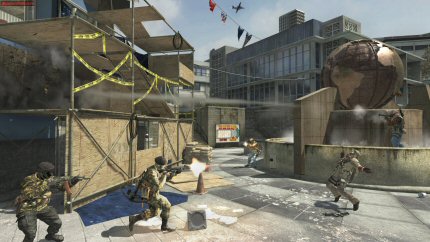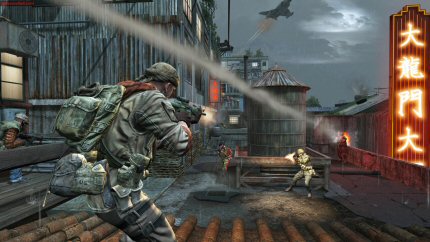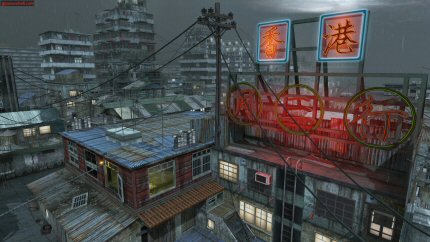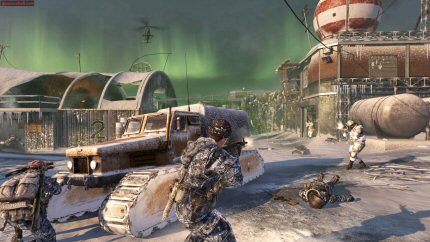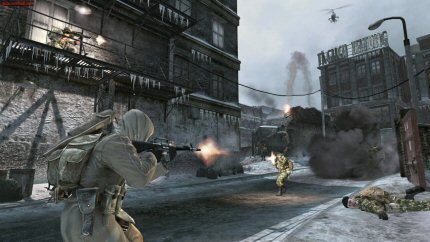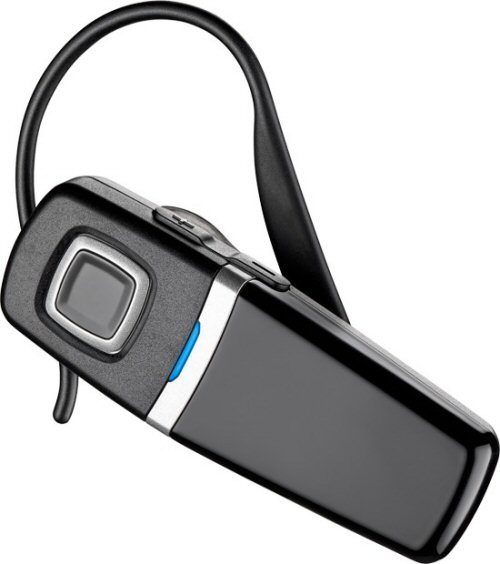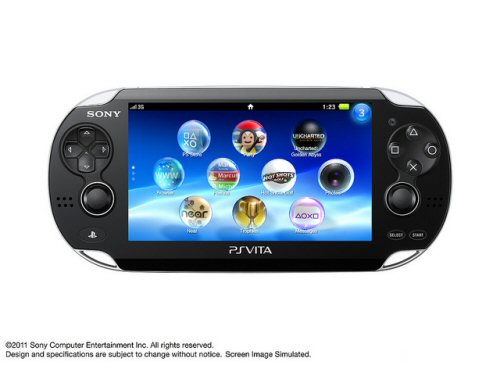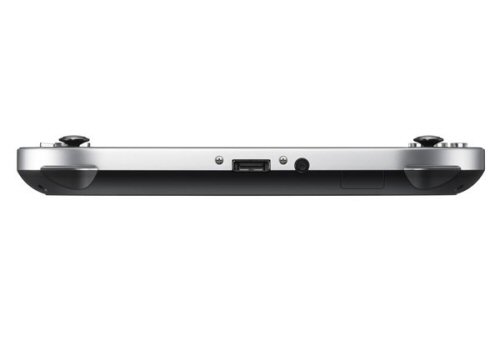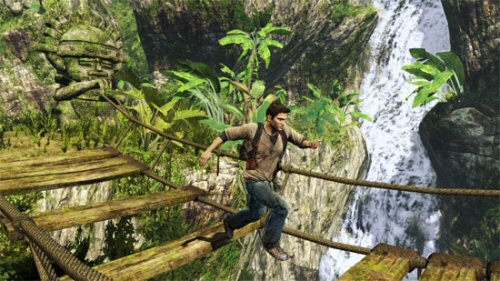E3 is a big deal for The Legend of Zelda: Skyward Sword, it seems. Shigeru Miyamoto first revealed the game's existence at the show two years ago, and the playable version of the game debuted at E3 2010. Skyward Sword is a pretty big deal this year, too, with the three-part demo being one of the standout titles on the show floor. On top of that, a live, closed-door demo by producer Eiji Aonuma at Nintendo's Developers Roundtable gave a clearer picture of some of Skyward Sword's deeper and more esoteric elements as well.

Click the image above to check out all The Legend of Zelda: Skyward Sword screens.
Skyward Sword's three-section public E3 demo consists of a dungeon, a boss battle, and a bird-riding sequence. Chronologically, the bird-riding appears to come first -- it's a competitive sporting event set in Link's skybound hometown, and the hero participates in it while wearing a rustic tunic rather than his usual green garb. Unfortunately, it drags on a bit, seemingly upholding the recent Zelda tradition of starting out a little too slowly.
The bird-riding event feels vaguely Harry Potter-inspired, as four boys on birds chase a golden bird, trying to grab a statue affixed to its tail feathers. After a while, the other competitors start chucking eggs at Link to slow him down. I will refrain from making references to bludgers and snitches and such, because I'd rather not embarrass myself... but in any case, Link's steed is controlled (like so much of Skyward Sword) with Wii Motion Plus.
The orientation of the Wii remote determines the pitch, yaw, and roll of the bird; the B button is a sort of brake; and the A button works exactly like Epona's carrots, making the bird dash forward briefly. It controls perfectly and is completely intuitive; the problem is just that it takes forever to complete the race. In fact, it's apparently so pokey that the lady demoing the game was surprised when I actually won; no one else had bothered/been able to finish the race. It's worth enduring the slow pace, though, as upon your victory you first meet this game's Princess Zelda, a slight girl with blond pigtail braids and rather Scandinavian features. It's a different look for Zelda, but her unique appearance helps define Skyward Sword as a game set in a far different time and place than the rest of the series.
The mediocre bird race marks a sour start for an otherwise extraordinary demo. The dungeon and bosses portion of the Skyward Sword demo show the potential of Wii Motion Plus to tremendous effect. Every element of the dungeon is keyed to a different facet of the system's advanced motion controls, yet it never feels fragmented or confusing. Link carries into the demo a handful of weapons: Bombs, arrows, a slingshot, and a boomerang-like beetle. Each of these plays a different role.
The beetle, for example, is used to target a crystal above a door that must be struck to unlock it. Once Link aims the beetle in the general direction of the crystal and releases it, players can control the course of its flight by twisting and rotating the controller. The arrows can be used to target skulltula-like spiders dangling from the ceiling, which are invincible under normal circumstances. Instead, you fire at their web strands, causing them to plummet to the ground. On the ground, the spiders remain largely invisible; only a sword strike from beneath can injure them, causing them to flip over and expose their vulnerable undersides. It sounds like a giant enemy crab joke waiting to happen, but in truth you don't really notice a gaming cliché in action because the act and urgency of properly striking the spider is too immersive. Striking a killing blow is satisfying, too -- you jab sharply downward with both the nunchuk and Wii remote, simulating the act of a powerful two-handed sword thrust. It's simple but effective.

Click the image above to check out all The Legend of Zelda: Skyward Sword screens.
Inside the locked door is a chamber where Link battles a massive Stalfos skeleton warrior. It's here that you realize Skyward Sword is a game about sword fighting, one that's determined to leave even Wind Waker's deft combat in the dust. The Stalfos has a wide array of battle postures, each of which leaves only a narrow defensive opening to strike. The bruiser can parry any strike with ease, and only by swinging at the proper angle can you inflict any damage at all. And this isn't a battle you can win by simply wailing away at the bad guy; try and press the advantage and the Stalfos quickly recovers, countering with a powerful blow that depletes about a quarter of Link's max health. Unlike other recent Zelda titles, which chip away at your health a measly quarter-heart at a time, Skyward Sword lays on the damage like it means it.
Impressive as the Stalfos battle is, it pales compared to the main event: a fight against what appears to be Skyward Sword's main villain, the Demon Lord Ghiraham. While decidedly effeminate-looking, wearing a white costume that exhibits a Harlequin-like design, Ghiraham is a stunningly capable swordsman. Again, the angle of Link's sword strikes is key here; attack Ghiraham's guard and he'll catch your blade between two fingers and hold, forcing you to pull fiercely in order to escape. While he plays a mostly defensive game at first, once you've inflicted a fair amount of damage he switches to a more aggressive posture, dashing at you with a tough-to-evade running strike and summoning projectiles. Skillful play is the key to victory here, and there's no one single correct pattern.
Unlike typical Zelda bosses, where you use a tool to expose a weak point and hit it three times, Ghiraham is all about bread-and-butter sword skills and doesn't have an easily exploited pattern. He can definitely be beaten, but it requires true skill. Producer Aonuma says, "As far as sword fights go, he can be pretty tricky, but with the new control mechanics introduced, I want to people to try it out and experience a boss fight with the motion controls."
While the show floor demo gives a sense of Skyward Sword's battle mechanics, its larger play concepts were revealed for the first time in Aonuma's demo. The first of these is dousing -- that is, using the sword itself to reveal things. Here he also revealed in action the spirit of the sword, Fie, who appears to be the phantom who will seemingly become the Master Sword. Fie first appeared in the Skyward Sword teaser art two years ago, a wraithlike girl (or girl-like wraith) whose face and cloak resemble the pommel and hilt of the classic Master Sword. Like all Zelda characters, Fie speaks in a form of gibberish, but hers is interesting -- her voice sounds like an autotuned Vocaloid.
With Fie in hand, Link can shift into a first-person view and use her sword form to guide him to key items. In the case of the E3 demo, those items came in the form of five shards of some sort of item for a pair of Crash Bandicoot-like creatures called Mogmas. Fie can lead Link to his MacGuffins, but this being a Zelda game, those MacGuffins will likely be hidden behind puzzles.
Interestingly, in the course of exploring and unlocking items, this Link is far more vocal than in previous games. He doesn't just shout when attacking or in pain but also grunt and moans and wheezes when he sprints. Speaking of sprinting, Link has a stamina meter that actually isn't entirely unlike the sprint meter in Halo Reach -- it empties as he runs and refills once he stops. Unlike in Reach, though, if you completely deplete the meter, Link becomes sluggish and winded for a while... a fact that ended up undermining the second portion of the closed-door demo, in fact.
That portion of the demo demonstrated new twists on some carryover mechanics from previous Zelda games. The first is the "Siren World," which is Skyward Sword's rendition of a longstanding series tradition: The dual world. Like the Dark World of A Link to the Past or the Twilit Realm of Twilight Princess, Skyward Sword's alternate dimension is a darker take on the main game world. It's saturated with blue or red, unlike the real world's largely green palette. And, much like the Dark World, it leaves Link almost completely helpless.
Herein lay the part that's likely to irritate fans. The core gimmick of the Siren World bears a striking resemblance to the central dungeons of Phantom Hourglass and Spirit Tracks: Invincible phantom guardians that cannot be fought, only evaded by dashing to safe zones. In Aonuma's demo, Link entered the Siren World by thrusting his sword into a symbol in the ground, leaving his weapon in the real world in order to unlock the alternate realm. Upon arriving, he was tasked with collecting a number of tear-shaped items before being caught by the guardians. His arrival point in the Spirit World was a sort of neutral turf that made him invisible to the guardians, but the instant he set foot on normal ground the guardians awoke and began pursuit. And since Link is defenseless in the Siren World, a single attack by a guardian spells the end.

Click the image above to check out all The Legend of Zelda: Skyward Sword screens.
Link has two weapons in the Siren World: His agility and his MacGuffins. The demo really showed off this Link's athleticism; he has access to a number of parkour-like moves such as scrambling up walls to reach cliffs that really lent him a sense of capability. But perhaps more importantly to the task at hand, the tear icons he collected would reset the guardians to their default positions and initiate a timer that determines when they'll move again.
Aonuma encourages gamers learn Skyward Sword's environments, as exploring areas in the "real" world will be a huge advantage when faced with Siren World challenges in the same area.
"Environments that lead to dungeons are like dungeons in and of themselves," he says. "Typically in a Zelda game, you clear an area and then move on, but this time you'll return to environments multiple times because there will be new challenges and puzzles to complete... The big idea here is becoming familiar with your environments and how they're laid out, because you're going to interact with them multiple ways."
There are a few dark clouds hovering over Skyward Sword's E3 presentation: The spectre of Phantom Hourglass' most despised mechanic, the dull bird-riding portion, and the fact that Nintendo was showing off a high-definition conceptual version of Zelda whose visuals utterly and completely put Skyward Sword's graphics to shame. Fortunately, the strength of the combat and the expansive world design do much to alleviate these concerns.
